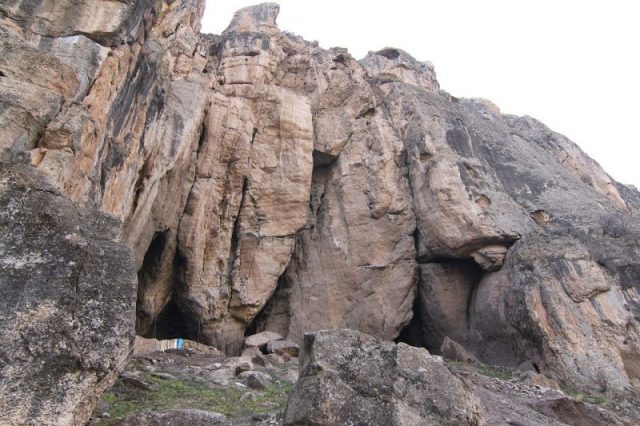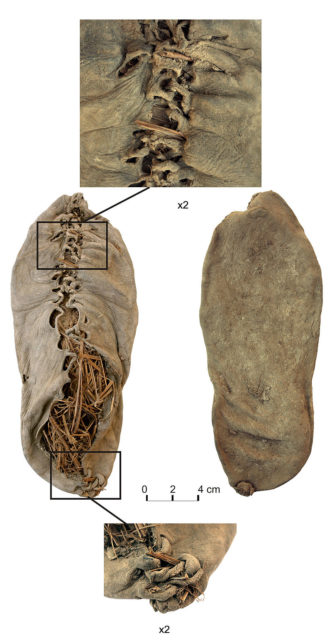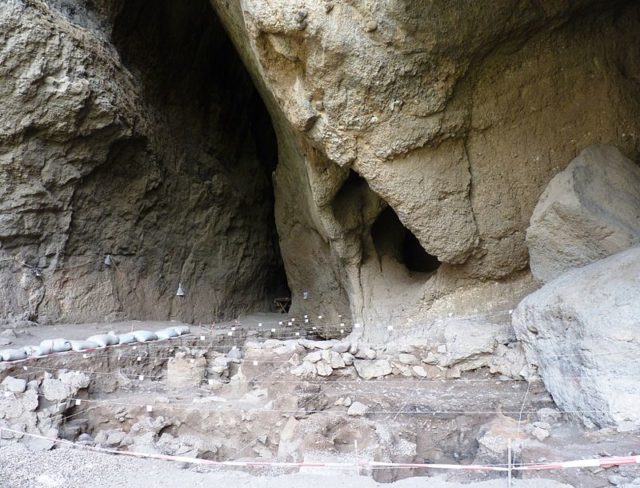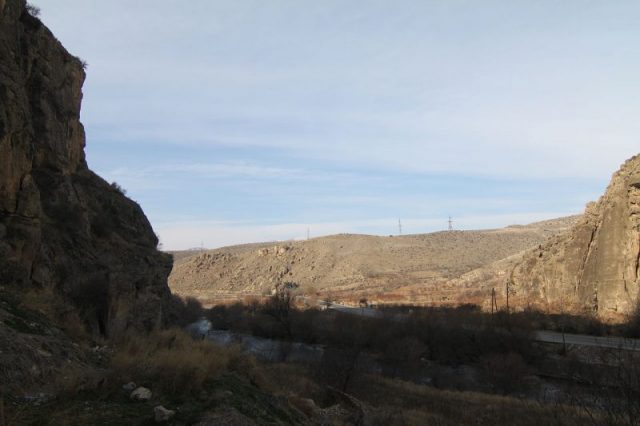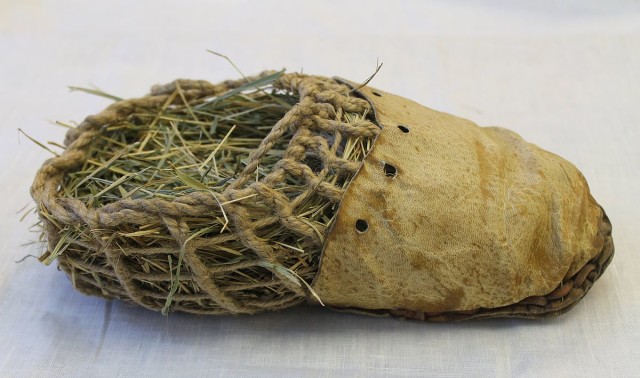Archaeologist report that a perfectly preserved
Archaeologist report that a perfectly preserved
Archaeologists 0 [A] that a perfectly preserved 5,500-year-old shoe has been discovered in a cav…
Archaeologists 0 [A] that a perfectly preserved 5,500-year-old shoe has been discovered in a cave in Armenia in south-west Asia. It is 1
to be the oldest leather shoe ever found. The shoe was made of a single piece of leather, stitched at the front and back, and was shaped to fit the wearer�s foot. It had been 2
with grasses, either for warmth or to make sure it kept its shape. �The shoe is relatively small but we can�t say for 3
whether it was worn by a man or a woman,� says Dr Ron Pinhasi, an archaeologist on the research 4
‘We thought at first that it was about 600-700 years old because it was in such good shape.’ Shoes of this type from later periods have turned 5
in archaeological excavations in various places in Europe, and shoes of a very similar design were still being used on the Aran Islands off the west coast of Ireland as 6
as the 1950s. It�s 7
a style which 8
popular for thousands of years.
0: (A) report (B) describe (C) inform (D) tell
1: (A) accepted (B) regarded (C) assessed (D) believed
2: (A) stuffed (B) loaded (C) pushed (D) blocked
3: (A) clear (B) specific (C) true (D) certain
4: (A) class (B) force (C) team (D) compan
5: (A) over (B) into (C) up (D) about
6: (A) recently (B) lately (C) presently (D) immediately
7: (A) correctly (B) exactly (C) precisely (D) obviously
8: (A) held (B) stood (C) remained (D) lasted
Archaeologist report that a perfectly preserved
RE: Archaeologists 0 [A] that a perfectly preserved 5,500-year-old shoe has been discovered in a cav…
Archaeologists 0 [A] that a perfectly preserved 5,500-year-old shoe has been discovered in a cave in Armenia in south-west Asia. It is 1
to be the oldest leather shoe ever found. The shoe was made of a single piece of leather, stitched at the front and back, and was shaped to fit the wearer�s foot. It had been 2
with grasses, either for warmth or to make sure it kept its shape. �The shoe is relatively small but we can�t say for 3
whether it was worn by a man or a woman,� says Dr Ron Pinhasi, an archaeologist on the research 4
‘We thought at first that it was about 600-700 years old because it was in such good shape.’ Shoes of this type from later periods have turned 5
in archaeological excavations in various places in Europe, and shoes of a very similar design were still being used on the Aran Islands off the west coast of Ireland as 6
as the 1950s. It�s 7
a style which 8
popular for thousands of years.
0: (A) report (B) describe (C) inform (D) tell
1: (A) accepted (B) regarded (C) assessed (D) believed
2: (A) stuffed (B) loaded (C) pushed (D) blocked
3: (A) clear (B) specific (C) true (D) certain
4: (A) class (B) force (C) team (D) compan
5: (A) over (B) into (C) up (D) about
6: (A) recently (B) lately (C) presently (D) immediately
7: (A) correctly (B) exactly (C) precisely (D) obviously
8: (A) held (B) stood (C) remained (D) lasted
Archaeologists 0 [A] that a perfectly preserved 5,500-year-old shoe has been discovered in a cave in Armenia in south-west Asia.
It is 1
to be the oldest leather shoe ever found. The shoe was made of a single piece of leather, stitched at the front and back, and was shaped to fit the wearer�s foot. It had been 2
with grasses, either for warmth or to make sure it kept its shape. �The shoe is relatively small but we can�t say for 3
whether it was worn by a man or a woman,� says Dr Ron Pinhasi, an archaeologist on the research 4
‘We thought at first that it was about 600-700 years old because it was in such good shape.’ Shoes of this type from later periods have turned 5
in archaeological excavations in various places in Europe, and shoes of a very similar design were still being used on the Aran Islands off the west coast of Ireland as 6
as the 1950s. It�s 7
a style which 8
popular for thousands of years.
0: (A) report (B) describe (C) inform (D) tell
1: (A) accepted (B) regarded (C) assessed (D) believed
2: (A) stuffed (B) loaded (C) pushed (D) blocked
3: (A) clear (B) specific (C) true (D) certain
4: (A) class (B) force (C) team (D) compan
5: (A) over (B) into (C) up (D) about
6: (A) recently (B) lately (C) presently (D) immediately
7: (A) correctly (B) exactly (C) precisely (D) obviously
8: (A) held (B) stood (C) remained (D) lasted
Nowdays extreme sports are quite popular.Some people think that it can help to build character,others think find them awfuly strssful and it’s difficult to understand why people put their lives at risk.
Ответ:
1.What is the most important thing in our lives is our family and friends. There’s nothing worse than being alone when no one loves you and you don’t love anyone, when there’s no one to take care of you and you don’t care about anyone. There is no one to share the grief, no one to ask for help. No wonder people always believe that one of the bitterest things in life is to be an orphan, and in some songs and ballads mourn the life of an orphan. In my opinion, we should protect our parents, because their love is priceless, and no other love can replace it.
2.Our family tradition is to always have dinner together as a family. Watch movies together, go out together on weekends.
3.It is impossible to say unambiguously what happiness consists in. But a strong family should stand by each other. All its members are United and friendly. In a strong family there are no quarrels, quarrels and conflicts. People try to spend all their free time together, which makes their relationship warm and friendly.
Нельзя сказать однозначно, в чем состоит счастье. Но крепкая семья должна стоять друг за друга горой. Все ее члены сплочены и дружны. В крепкой семье нет ссор, размолвок и конфликтов. Люди стараются проводить все свободное время вместе, что делает их отношения теплыми и дружественными.
This 5,500-Year-Old Leather Shoe is the Oldest Ever Discovered
The oldest leather shoe known to archaeologists was found embedded in a pit of sheep droppings in a cave in Armenia and is around 5,500 years old, according to a report by the BBC.
The so-called Areni-1 shoe is an example of early, basic footwear, which may have gone on to influence the development of other types of shoe design in the ancient world. According to LiveScience, anthropologists believe that humans started wearing shoes around 40,000 years ago, contributing to anatomical changes in human feet and limbs. However, we have very little idea of what these prehistoric shoes might have looked like.
Entrance to the Areni-1 cave in southern Armenia near the town of Areni. The cave is the location of the world’s oldest known winery and where the world’s oldest known leather shoe has been found. Photo by Serouj CC BY 3.0
Several pairs of rope sandals discovered by archaeologists in a cave in Oregon are thought to be the oldest footwear ever discovered, dating to approximately 8,000 BC. However, the oldest shoe, made from leather and featuring a closed toe, was found in a remote cave in Armenia in 2008. The shoe was excavated as part of a project led by archaeologists from the Institute of Archaeology and Ethnography of the National Academy of Sciences of Armenia.
The Areni-1 shoe. Photo by Pinhasi R, Gasparian B, Areshian G, Zardaryan D, Smith A, et al. PLoS ONE 5(6): e10984. CC BY 2.5
The team was exploring a cave known as Areni-1, in the Vayots Dzor region. Areni-1 contained a number of Neolithic and Copper Age remains, including food containers holding barley, wheat and apricots.
The shoe itself was found inside a pit, perfectly preserved in the cool, dry conditions of the cave. It was cemented in with several layers of sheep droppings, which acted as a seal, protecting the contents of the pit from the air and water.
The Areni-1 shoe was made from a single piece of tanned leather from the hide of a cow. It was seamed at the front and the back and tied together with leather cords, and appears to have been made to measure.
According to National Geographic, the leather was probably wrapped around the foot before stitching to ensure a tight fit. It corresponds to a size 7 (US) in modern footwear, and so could have conceivably been worn by either a man or a woman.
The archaeological site of Areni-1 in 2012. Photo by Kiwiodysee CC BY-SA 2.0
The shoe was also found stuffed full with grass. The archaeologists could not determine whether this was intended as a way to ensure that it held its shape while not being worn, or whether it was insulation designed to keep the wearer’s feet warm.
The Areni-1 shoe was carbon dated to around 3,500 BC, making it the oldest footwear of its kind ever to be discovered. Shoes would have been particularly important to the Copper Age inhabitants of the cave, as the area around the site is well known for its rocky terrain, with sharp, pointed rocks and thorny plants.
View from the Areni-1 cave. Photo by Serouj CC BY 3.0
The shoe itself showed considerable signs of wear and tear, particularly at the heel and ball of the foot, suggesting that the wearer habitually walked very long distances.
This assumption is further supported by the other items discovered in the cave including obsidian, thought to have been brought from a site over 75 miles away.
According to National Geographic, the Areni-1 shoe appears to be an example of the earliest leather footwear designs, creating a basic prototype that would be exported throughout the region.
Replica of the footwear worn by Ötzi The Iceman (about 5000-years-old) found in Alps. Photo by Josef Chlachula CC BY SA 2.0
The shoe closely resembles other ancient shoes discovered in the Middle East and North Africa, and even draws comparison with traditional clothing from the Balkans and North Africa, which are still worn in festivals today. In particular, it bears close similarly to the opanke, a form of traditional Balkan footwear.
The second oldest leather shoe discovered by archaeologists was found on Ötzi “the Iceman”, a mummified ancient man uncovered in the Austrian Alps and dating from between 3,400 and 3,100 BC.
Reconstruction of Otzi the Iceman. Photo by Thilo Parg CC BY SA 3.0
Ötzi’s shoe was significantly more sophisticated, comprising a bearskin base and deerskin side panels, pulled tight with a bark-string net. Dating just a few hundred years after the Areni-1 shoe, Ötzi’s shoe represents a significant leap forward in footwear design and technology.
Nevertheless, the Areni-1 shoe provides an important and extremely rare insight into the clothing and footwear worn by the Copper Age inhabitants of Armenia. Today it is on display in the History Museum of Armenia in Yerevan.
Ancient Shoe Steps up Archaeological Insight
An international team that includes eight researchers and students from UCLA’s Cotsen Institute of Archaeology has found a perfectly preserved, 5,500-year-old shoe in a cave in Armenia.
Believed to be the oldest leather shoe ever discovered, the find dates back to around 3,500 B.C. and was announced today (June 9) in the online scientific journal PLoS ONE.
«Generally, organic materials are poorly preserved in Middle Eastern archaeological sites because of the high content of salts and fungi in the soil and dramatic fluctuations in the temperatures and humidity in the weather,» said Gregory Areshian, a visiting associate professor at the Cotsen who was nearby when the discovery was made. «But the condition of this shoe is amazing.»
«While small, the shoe could well have fit a man from that era,» said Ron Pinhasi, the study’s lead author and a lecturer in archaeology at the University College Cork in Cork, Ireland.
The discovery was made in Armenia’s Vayotz Dzor province, on the country’s border with Iran and Turkey. The cave’s stable, cool and dry conditions are credited with the exceptional condition of the various objects that were found there, including large containers, many of which held well-preserved wheat and barley, apricots and other edible plants. The preservation was also helped by the fact that the floor of the cave was covered by a thick layer of sheep dung, which acted as a solid seal over the objects.
«The crusts had sealed the artifacts and archaeological deposits, and the artifacts remained fresh-dried as if they were put in a can,» said Areshian, who served as dig co-director with Boris Gasparyan, a researcher at the Institute of Archaeology, Armenia.
The shoe was discovered by Diana Zardaryan, a graduate student at the Institute of Archaeology, Armenia, in a pit that also included a broken pot and wild goat horns. «I was amazed to find that even the shoelaces were preserved,» she recalled.
While the Armenian discovery is believed to be the oldest example of enclosed footwear made of leather, a pair of leather sandals and a single moccasin made of plant material by American Indians remain the oldest known footwear to date. Predating the Armenian shoe by as many as 2,000 years, the American Indian footwear was discovered in the 1970s in a cave in Missouri. Another pair of leather sandals that have been dated to the same era as the Armenian shoe was found in Israel’s Judean Desert in 1993.
But the researchers are more certain of the age of the Armenian shoe than scholars are of the two other sets of footwear. Strips of leather taken from the Armenian shoe were dated independently of each other in labs at the University of Oxford and the University of California, Irvine. The older footwear was not directly dated; the age of those finds was based on various other associated artifacts.
Interestingly, the Armenian shoe is very similar to the «pampooties» worn in the Aran Islands on Ireland’s west coast up to the 1950s, said Pinhasi. «In fact, enormous similarities exist between the manufacturing technique and style of the [Armenian] shoe and those found across Europe at later periods, suggesting that this type of shoe was worn for thousands of years across a large and environmentally diverse region.»
Источники информации:
- http://matfaq.ru/answer/re-archaeologists-0-a-that-a-perfectly-preserved-5500-year-old-shoe-has-been-discovered-in-a-cav/
- http://otvet.ya.guru/questions/4148562-archaeologists-a-that-a-perfectly-preserved-5-500-year-old-shoe.html
- http://www.thevintagenews.com/2019/05/08/areni-1/
- http://www.sott.net/article/210251-Ancient-Shoe-Steps-up-Archaeological-Insight
